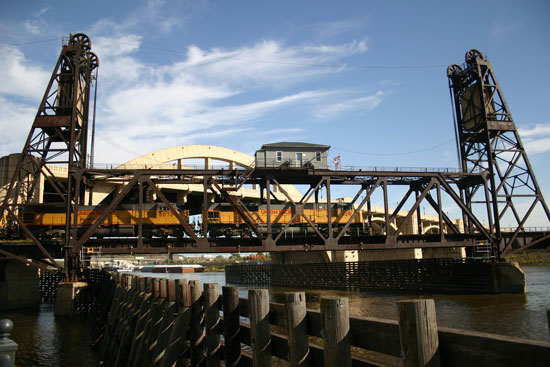This tour will view historic bridges of the Twin Cities from the deck of a Mississippi riverboat, cruising from the waterpower center of the Historic Minneapolis Mill District at the Falls of St. Anthony to the traditional head of navigation at St. Paul. To follow the river route in detail, see navigation charts 12, 13, and 14 at the U.S. Army Corps of Engineers website.
Although this is largely a river tour, we start out with a short bus ride from the hotel to the Seventh Street Improvement Arches (1884) in St. Paul, one of the few helicoidal stone arches in the U.S. Minnesota State Bridge Engineer Nancy Daubenberger will welcome us to the bridge tour and to this ASCE National Historic Engineering Landmark, one of only three in Minnesota. We’ll see the second landmark shortly.
After walking through the twin helicoidal arches, we’ll reboard the bus for the drive to St. Anthony Falls in Minneapolis. During the ride, Denis Gardner, author of Wood, Concrete, Stone, and Steel: Minnesota’s Historic Bridges (U. of Minn. Press, 2008) will introduce the story of bridge building in Minnesota.
As we head toward the Mississippi riverfront in Minneapolis, the bus will pass notable historic buildings, landmarks, and bridges, ending at the east side of St. Anthony Falls, the only falls in the entire length of the Mississippi. We’ll cross the river at the Falls by walking the deck of the 1883 Stone Arch Railroad Bridge, the second ASCE National Historic Engineering Landmark and now a ped/bike crossing. The 2,100-foot, 23-arch bridge includes a six-degree curve. The walk allows time for discussions of the bridge, the geology of the Falls and the waterpower by John Anfinson (author of The River We Have Wrought: A History of the Upper Mississippi, U. of Minn. Press, 2005), and a quick introduction to the development of flour milling here. Visible on the walk are two National Historic Landmark flour mills, the Pillsbury A Mill (1881) the Washburn A Mill (1879), predecessor to General Mills.

Aerial view of St. Anthony Falls, Minneapolis. The whitewater at center is the Falls. The long bridge below the falls is the 1883 Stone Arch Bridge, which we’ll walk across from east (right) to west (left). At the west end is the Upper Lock where we’ll board the boat. The curving bridge above the falls is the Third Ave. Bridge (1914-16, 1949, 1981). Historic mills include Washburn A Mill (west) and Pillsbury A Mill (east). Photo: Wikimedia Commons/NPS
The west end of the bridge terminates at the Upper Lock & Dam, where we’ll board our riverboat, the Magnolia Blossom, from the top of the lock chamber if river conditions allow. From here on it will be a river cruise for the remainder of the day, buffet lunch included, ending in downtown St. Paul near the hotel.
Almost immediately upon leaving the Falls area we’ll pass beneath the new I-35W bridge and site of the infamous 2007 bridge collapse. Entering the Mississipi’s upper gorge, we’ll pass under a quick succession of substantial railroad and vehicular bridges, including the Cappelen Memorial (Franklin Ave.) Bridge (NR), whose 400-ft. main span was the world record concrete arch span when the bridge was completed in 1923. This bridge is among an important group of large reinforced-concrete arch bridges that were built in the Twin Cities, particularly over the Mississippi, in the 1920s.

Cappelen Memorial (Franklin Avenue) Bridge, 1923. Photo: Hennepin County Library
Continuing downriver, we’ll lock through Mississippi River Lock and Dam No. 1, which is at the site of the recently closed Ford plant and its power sources, the Ford hydroelectric plant (operating) and steam plant (closed; Thursday tour site). This is one of the few stretches of river that serves as the border between Minneapolis and St. Paul. That river division is marked by the Inter-City (Ford Parkway) Bridge (1925-27), another major concrete arch structure.
We’ll cruise past Historic Fort Snelling, now restored to its 1820s appearance, high up on the bluff above the confluence of the Mississippi and Minnesota rivers. At that point we’ll take a short excursion up the Minnesota to the Mendota Bridge, which was the world’s longest continuous-concrete-arch bridge in the world when completed in 1925-26. It was the work of Minnesota’s two legendary engineers, C.A.P. Turner and Walter Hall Wheeler.

The Mendota Bridge under construction, 1925. Photo: Minnesota Historical Society
Returning to the Mississippi and heading into St. Paul, we pass under more bridges, including the Omaha (railroad) Swing Bridge (1915) and a series of riverside industrial sites, including two steam power plants and the surviving headhouse of the Farmers Union Grain Terminal. The downtown area includes the C&NW Vertical Lift Bridge (1913/1925), built adjacent to the massive concrete rainbow arch of the Robert Street Bridge (1924-26). At this point we’ll be in the working river harbor area of tow boats and barges, which will be described by another onboard guide who is the Dispatcher of Upper River Services.

The CGW/C&NW railroad lift bridge (1913/1925) in downtown St. Paul.
Behind is visible the rainbow arch Robert Street Bridge (1924-25). Photo: Bob Frame
A view of one last bridge, the restored St. Paul Union Depot (see Sunday tours), and the downtown St. Paul airport, Holman Field, will complete the journey. We’ll dock at Harriet Island, across the river from downtown, and take a short bus ride back to the hotel to end our day.
This tour will be a full day, although exact times will vary depending on river levels and currents. Be aware that two-thirds of this tour is by boat. Please dress appropriately.